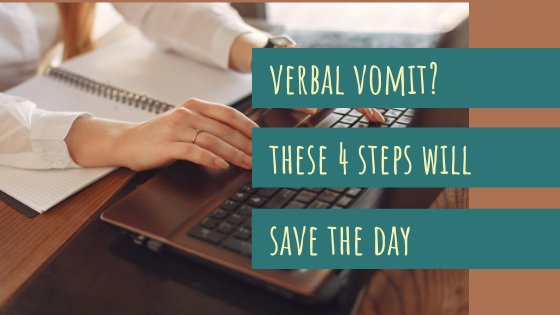You’re tippy-tapping along like a Kermit the Frog GIF. Yes! You’re on a roll. You’ll have this blog post / email / social post / video script finished in no time!
<<Cut to an hour later and your writing is still growing. >>
The ideas keep flowing. Except now they no longer feel energizing. They’re starting to weigh on you. You feel lost. Where are you going? And how are you going to get there?
Hey big thinker, I’ve got your back. You’re experiencing the agony and ecstasy of being an idea magnet. Ideas love you. They flock to you. They keep filling up your head and heart. That’s wonderful. As long as you know how to corral them.
Here’s a simple 4-step process that will organize your ideas and help you make sense of them so you can finish writing instead of feeling overwhelmed.
Step 1: Add Sections and Subheadings
Subheadings are a great way to reverse-outline your post. To figure out what it’s really about and which ideas go together.
Reverse-what now? Reverse-outline. It’s like regular outlining, but so much more useful for big thinkers who get a rush of inspiration and want to take action on it right away.
Reverse-outlining is the process of superimposing a structure onto a draft you’ve already written. It allows you to trust your intuitive process and get the words out of your heart and onto the page — and then come back later and figure out how they go together. You start with what you have, and then you see what you can do with it.
First, stop writing. Wherever you are. (You will get to write more later, I promise!)
Now read back through what you’ve written and start annotating using the comment feature in your word processing software or print out what you have and write notes in the margin
Ask yourself:
- “What is this section about?”
- “What’s the main idea here?”
- “What ties these ideas together?”
- “What connects these paragraphs?”
When you get big concepts, write them as subheadings in your draft. These are landmarks that tell you the purpose of different parts of your draft.
Now start cutting and pasting things to put similar ideas together under the subheadings that make sense. This is a process of putting like with like.
Bonus
Subheadings help your reader see what your content is all about. When we’re reading online, we all skim and scan. (Even if IRL we’re big readers.) Subheadings are eyeball landmarks. They’re also Google bot magnets, improving your chances or ranking in a search.
If you’re writing a video script, your subheadings will help you make smooth transitions. Instead of awkwardly diving into the next idea, you’ll have a natural yet expert phrase such as, “After that, the next step is…” “But hold on, there’s one more secret I want to share with you!” or “Finally, the last big mistake to avoid is…”
Step 2: Discern and Cut
Look at all the sections you have and the subheadings you’ve given them. What are you really writing about?
And, more importantly, what are you really excited to be writing about?
Ask yourself:
- “Why did I start writing this piece?”
- “What am I responding to?”
- “What was the question I wanted to answer?”
- “What is my intention or purpose?”
Turn on your discernment and categorize each section:
- Which sections are essential to achieve your intention for this piece?
- Which sections are nice to have but not essential?
- Which sections distract or detract from your intention? Where did you go off on a tangent?
First, cut the distractions and tangents. Don’t delete them. Stash them in a “Storage” section at the bottom of your draft for now.
Next, cut and paste the nice to haves down to the bottom of the doc. Put your essentials in an order that makes sense and flows. Take an honest look at what you have and ask whether it would be improved by any of your nice-to-haves.
Make sure you do this thinking about the success of the piece as a whole, not thinking about how much you love that one sentence you came up with.
Bonus
Anything you cut that was outside the scope of your intention is likely an idea for another post. This is how we big thinkers roll! You ask your brain to give you what it’s got on a topic, and it’s like, “Sure! Let me download everything I can think of!” Take those ideas you put in storage and add them to your idea folder or your Dump doc. Voila! More content ideas!
Step 3: Sum it Up
Now that you’ve gotten clear on your intention for this piece, time to put it in writing.
Go back to the top of your doc and create a promise statement.
Ask yourself:
- “What is the main thing readers will understand from reading this?”
- “What’s the big concept that ties things all together?”
- “What is this piece of writing really about?”
- “What value will someone gain from reading this?”
Don’t make things harder than they need to be. Maybe the answer to these questions is already staring you in the face in the answers to the questions from Step 2.
Now put that idea into a frame like one of these:
“In this post, you’ll learn why / how / what / when / where / who _________________.”
“In this post, you’ll learn [#] reasons why _____________________.”
“In this post, you’ll learn [#] steps to _____________________.”
“In this post, you’ll learn the secret to _____________________.”
“In this post, you’ll learn [#] mistakes people make when _____________________.”
“In this post, you’ll learn a simple trick to _____________________.”
Finally, rename your subheadings to match your promise statement. For example, if I promise to give you the three steps in a process, it’s pretty helpful if I deliver the subheadings as numbered steps and / or action items.
Your promise statement acts as an organizing statement. (It’s like a thesis statement — unless that phrase gives you bad flashbacks. In which case, what I really said was Theseus. I’m just obsessed with Greek mythology.)
Bonus
Yes, your promise statement keeps you on track, including only the sections that will help you achieve your specific purpose for this piece of writing. But it also tells readers exactly what they’re going to get. That gives them a reason to keep reading. The value is clear from the beginning.
Step 4: Determine Whether You’re Done
Congratulations. You’ve made order out of chaos.
Now it’s time to figure out if you need to write more. (Remember, I promised you that you’d be able to do this!)
Ask yourself:
- “Does each section feel complete?”
- “Are some sections way longer than others?”
- “Is there another section I could add that would make this piece more clear, complete, or compelling?”
- “Do I have a hook?”
- “Do I have a conclusion that wraps up all my ideas?”
If you have more writing to do, go for it! Dive in.
But do me one favor first: Speak your intention aloud.
This might sound like…
“I’m going to add another example to section _____________.”
“I’m going to add more explanation to section _____________.”
“I’m going to add one more reason / step / mistake because readers really need to know ______________.”
“I’m going to add a hook about ____________.”
“I’m going to add a call to action asking people to ____________.”
Now you can dive back into writing knowing exactly what you want to achieve.
Bonus
Now that you’ve just taken a long, hard look at your writing and what you didn’t need, your brain is in discernment mode. You’ll be less likely to get another fit of verbal diarrhea. You’ll be focused and on task and likely surprise yourself with how quickly you finish.
Embrace the Flow
Now you know the steps to tame your content explosions any time they occur. Not only will this practice save you time and frustration, you’ll end up with better content. It will be focused and compelling, so your audience will really get the value of what you’re sharing. Plus, you’ll discover you have more content than you thought you had as you cut those tangents and move them into your idea folder.
Can I promise you no more verbal diarrhea? Sorry, no can do. You’re a big thinker. Ideas flow to you and through you. You’re not only creative, you’re connected to divine creativity, and she wants to share all her gifts with you.
Trust me. You don’t want to turn off the creative flow. You don’t want the ideas to dry up. Being a big, bold thinker is part of who you are. It’s actually one of your gifts. Now you know more about how you can contain your gift. This will help you share your magic message with greater ease and flow, and a much bigger impact.

